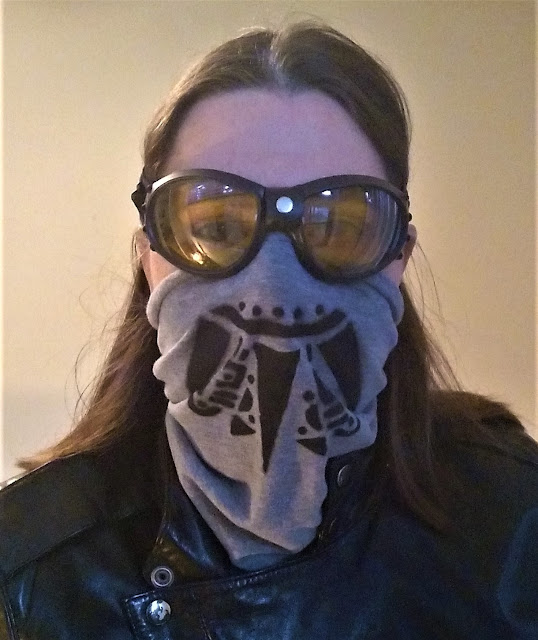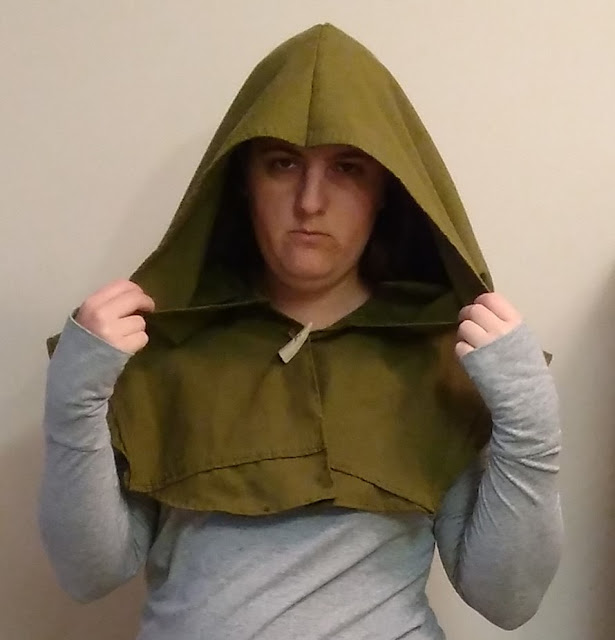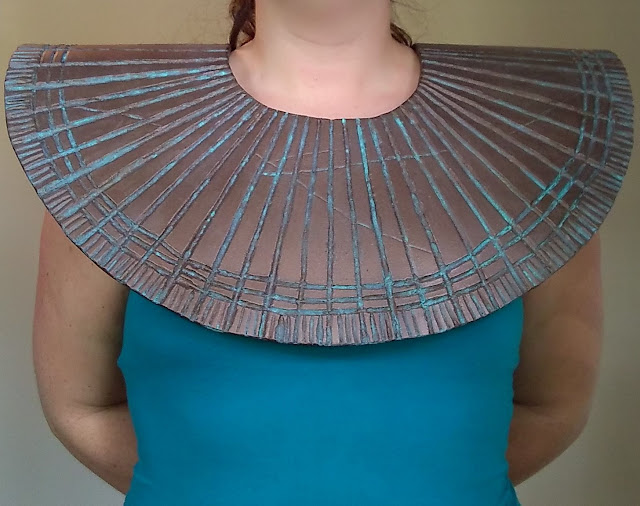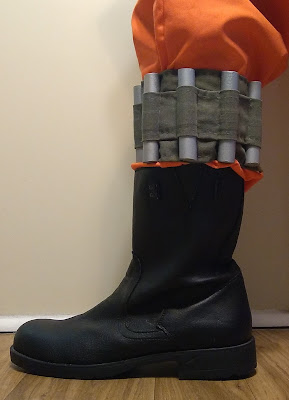How to make a traveler's buff with custom designs
I had been thinking of what kinds of things I like to have with me when hiking into nowhere. One extremely handy piece of clothing is a buff, which is essentially a flexible band of fabric that can be worn in several different ways. Mostly I've used a buff as a mask against breathing dust and to keep my neck warm, but it can also be used as a headscarf, etc. I remember first seeing them as a kid on the reality TV series Survivor, though undoubtedly they were used long before then.
And worn as a head scarf:
So though I've owned a buff for a long time, I wanted to see if I could make my own functional buff. I could use in the field and in my post-apocalyptic costume build. It doesn't seem terribly complicated, and so I set about looking for tutorials online to get the gist of it and figure out if there were any pitfalls. Buff are pretty useful because, if done right, it can be used many ways. Here are the details from the original Buff company.
I ended up following the tutorial drawn up by Melissa Fehr. The only differences are choice of material (recycled T-shirt rather than special material), using a zigzag stitch (rather than serging), and adding a customizable design to the buff.
Materials
-Old T-shirts of thin, soft material
-Fabric spray paint
-Cardboard for making stencils
Tools
-Sewing machine or needle/thread
-Scissors
-Hobby knife
-Hole punch
1. Gather the materials
I bought a few different T-shirts at a thrift store for about $3 each, but of course you could just use an old T-shirt from your closet as well. When hunting for shirts I was looking for material that was soft, thin, and muted in color. A buff will be rubbing against the neck and face, so obviously you'd want it to be soft. Thinner T-shirts are more useful in they be folded and more flexible, which is also what you want in a buff. You can find fabric spray paint from any decent craft store, as it's a common item in the section for DIY clothing projects.
2. Cut the material
Cut a rectangular piece of the T-shirt front that is 18 inches along the vertical side and about 19 inches. This should work out well if you have a larger T-shirt.
Here's what it should it should look like when cut.
3. Sew the buff
First fold the material in half from left to right. The two raw edges should be then pinned together along this right edge, the inside of the T-shirt facing outward.
To join the raw edges together, I used a zigzag stitch set at the widest stitch width on my machine (on my nifty Singer Tradition 2277 it's "5"). I don't have the extra gear to properly serge the edges, but using running a zigzag stitch as close to the edge ought to help keep things from fraying. Careful though, the stretchiness of the material will make it easy for the edge to catch on the foot of the machine and mess up the stitch.
I then switched to a regular running stitch and went over the top of the zigzag for just as extra reinforcement. Not the prettiest, but this will be on the inside so it won't be seen anyway. When finished, turn the buff inside out.
4. Create the stencil
There are lots of options for adding designs on the buff. I have plans to also create one with the outlines of a map on it, but for my first try I decided on a simpler, smaller design. Instead of painting a design across the entire buff, I decided to limit it to the part of the buff that would show when pulled up over the face (when worn as a mask) or on the forehead (when worn as a head scarf). Because most of the time a larger design is not very visible. I drew up a sort of stylized sun motif with geometric shapes, not really any particular culture but vaguely tribal. I cut it out with the help of a hobby knife, and using a hole punch to add a few circles.
5. Paint the design
To have it the position where it would be visible when worn as a mask, I laid the buff out so that the seam is in the center back. Towards the top of the buff, but not on the very edge, tape the stencil in place.
Next, be sure to cover the all the other exposed areas of the buff.
Then use a fabric spray paint to apply a few layers of paint onto the stencil. Be sure to follow the instructions for use on the container.
6. Finishing touches
Actually there's not much else to do except let it dry and admire your handiwork. I would say wait maybe 24 hours before wearing, because there are some lingering paint smell. And of course be careful about how you wash it. But here's how mine came out:
And here's a close up:
So good luck and keep crafting!
And worn as a head scarf:
So though I've owned a buff for a long time, I wanted to see if I could make my own functional buff. I could use in the field and in my post-apocalyptic costume build. It doesn't seem terribly complicated, and so I set about looking for tutorials online to get the gist of it and figure out if there were any pitfalls. Buff are pretty useful because, if done right, it can be used many ways. Here are the details from the original Buff company.
I ended up following the tutorial drawn up by Melissa Fehr. The only differences are choice of material (recycled T-shirt rather than special material), using a zigzag stitch (rather than serging), and adding a customizable design to the buff.
Materials
-Old T-shirts of thin, soft material
-Fabric spray paint
-Cardboard for making stencils
Tools
-Sewing machine or needle/thread
-Scissors
-Hobby knife
-Hole punch
1. Gather the materials
I bought a few different T-shirts at a thrift store for about $3 each, but of course you could just use an old T-shirt from your closet as well. When hunting for shirts I was looking for material that was soft, thin, and muted in color. A buff will be rubbing against the neck and face, so obviously you'd want it to be soft. Thinner T-shirts are more useful in they be folded and more flexible, which is also what you want in a buff. You can find fabric spray paint from any decent craft store, as it's a common item in the section for DIY clothing projects.
2. Cut the material
Cut a rectangular piece of the T-shirt front that is 18 inches along the vertical side and about 19 inches. This should work out well if you have a larger T-shirt.
Here's what it should it should look like when cut.
3. Sew the buff
First fold the material in half from left to right. The two raw edges should be then pinned together along this right edge, the inside of the T-shirt facing outward.
To join the raw edges together, I used a zigzag stitch set at the widest stitch width on my machine (on my nifty Singer Tradition 2277 it's "5"). I don't have the extra gear to properly serge the edges, but using running a zigzag stitch as close to the edge ought to help keep things from fraying. Careful though, the stretchiness of the material will make it easy for the edge to catch on the foot of the machine and mess up the stitch.
I then switched to a regular running stitch and went over the top of the zigzag for just as extra reinforcement. Not the prettiest, but this will be on the inside so it won't be seen anyway. When finished, turn the buff inside out.
4. Create the stencil
There are lots of options for adding designs on the buff. I have plans to also create one with the outlines of a map on it, but for my first try I decided on a simpler, smaller design. Instead of painting a design across the entire buff, I decided to limit it to the part of the buff that would show when pulled up over the face (when worn as a mask) or on the forehead (when worn as a head scarf). Because most of the time a larger design is not very visible. I drew up a sort of stylized sun motif with geometric shapes, not really any particular culture but vaguely tribal. I cut it out with the help of a hobby knife, and using a hole punch to add a few circles.
5. Paint the design
To have it the position where it would be visible when worn as a mask, I laid the buff out so that the seam is in the center back. Towards the top of the buff, but not on the very edge, tape the stencil in place.
Next, be sure to cover the all the other exposed areas of the buff.
Then use a fabric spray paint to apply a few layers of paint onto the stencil. Be sure to follow the instructions for use on the container.
6. Finishing touches
Actually there's not much else to do except let it dry and admire your handiwork. I would say wait maybe 24 hours before wearing, because there are some lingering paint smell. And of course be careful about how you wash it. But here's how mine came out:
And here's a close up:
So good luck and keep crafting!
















Comments
Post a Comment